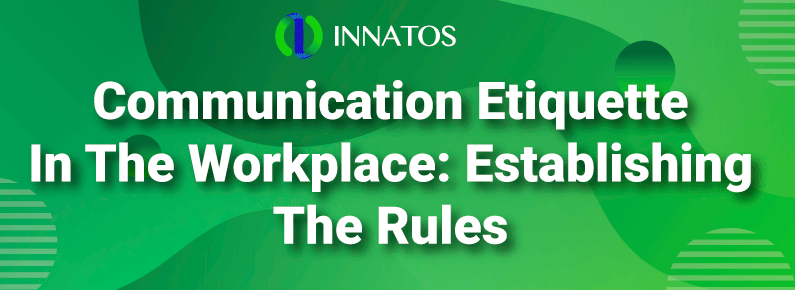Communication Etiquette In The Workplace: Establishing The Rules
Communication Etiquette In The Workplace: Establishing The Rules. Providing different tools and platforms for your staff to communicate is essential to help build a workplace where people can share information and ideas, get to know one another better, build relationships, establish trust, and feel engaged with the organization.
When your staff can have an open exchange with one another they can collaborate better. In many workplaces, information silos have developed over time where, for example, some teams don’t interact with other teams very often or very well. Any tools you can provide, whether it is intranet chatrooms, team apps, instant messaging, and so on can help to connect your employees, establish a collaborative culture and improve teamwork.
At the same time, you need to establish rules and protocols around the etiquette of using the different tools that you provide.
If not used properly they could have the opposite result of what you are hoping to achieve by making them available:
- People could avoid them altogether,
- They could contribute to information overload,
- And they could cause offense and upset people, result in a loss of productivity and even land your company in legal trouble.
But you need to be careful that you don’t over-regulate this sphere. Nobody enjoys being micro-managed and too many rules and regulations could lead to people feeling stifled and unable to freely and naturally communicate with one another.
According to Liam FitzPatrick, Managing Partner at Working Communications Strategies and Partner Donhead Consultants, communications teams can be their own worst enemy when they get involved in trying to control how communications tools are used by employees:
“In particular, communicators spend an awful lot of energy in trying to get people to do things differently at work – but that often means telling them to break rules that were last year’s big priority. We preach a gospel of innovation, of free-thinking, and of working ‘outside the box. Yet we love creating our boxes about what is appropriate or necessary to maintain a good flow of communications”.
He also cautioned communicators who can erroneously believe that only professional communicators can influence management.
“I’ve heard comms managers attempt to control the tsunami of demand for support by creating rules about how requests for intranet space are managed or what gets talked about on Yammer or Slack. There are plenty of comms pros who dare not upset the HR department by creating their intelligence gathering operation even though it stops them doing their job,” FitzPatrick said.
-
How to navigate the process of establishing communication etiquette in the workplace.
 Set expectations with your employees about what is appropriate and what isn’t appropriate when it comes to workplace communication.
Set expectations with your employees about what is appropriate and what isn’t appropriate when it comes to workplace communication.
This includes keeping language professional and respectful, being mindful of tone, ensuring written communications are free from errors and parameters about how and when certain platforms and tools should be used or avoided.
Of course, proper email etiquette in the workplace should also dictate that written communication should be free from spelling and grammatical errors.
-
Recognize some tools that will be used with an informal communication style.
 People are used to using text messages, instant messengers, chat rooms, social media comments, and other online platforms to communicate with their families, friends, and people they don’t know in their personal lives. Over time, they may have adopted a less formal communication style they feel naturally comfortable within these sorts of platforms.
People are used to using text messages, instant messengers, chat rooms, social media comments, and other online platforms to communicate with their families, friends, and people they don’t know in their personal lives. Over time, they may have adopted a less formal communication style they feel naturally comfortable within these sorts of platforms.
When they use them at work, some of that less formal style is going to creep in. This might include using emojis or acronyms such as LOL (“laugh out loud”). A relaxed approach to governing these quirks of the online world will help communication to flow effectively and naturally among your teams.
That’s not to say you shouldn’t have any instant messaging etiquette in the workplace at all. There still need to be parameters, such as appropriate language (no swearing for example). There should also be guidelines about the types of conversations that are acceptable.
You may also need to set limits on how long people can spend using instant messengers each day so the privilege isn’t abused.
-
It’s not all online! Don’t forget verbal interactions, Communication Etiquette In The Workplace.
 The staff interacts with one another verbally all the time, whether it’s in meetings, chatting in the hallways, on the phone or videoconferencing, or sitting next to each other at their desks. Some of these conversations will be formal, some of these conversations will be casual.
The staff interacts with one another verbally all the time, whether it’s in meetings, chatting in the hallways, on the phone or videoconferencing, or sitting next to each other at their desks. Some of these conversations will be formal, some of these conversations will be casual.
Verbal communication etiquette in the workplace is important regardless of the type of conversations people are having.
Verbal conversations should always be respectful, free from discriminatory language or swearing. The volume of the conversation (for example, yelling) should also be a factor, as is tone. For example, sarcasm, when someone doesn’t want to do a job their manager, is asking them to do.
Employees may get enormous value out of training and coaching in this area to ensure they are having respectful conversations in the workplace and to help them to deal with having difficult conversations where people might get upset or emotional and communication can break down.










Leave a Reply
Want to join the discussion?Feel free to contribute!